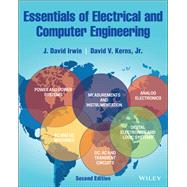Essentials of Electrical and Computer Engineering is for an introductory course or course sequence for nonmajors, focused on the essentials of electrical and computer engineering that are required for all engineering students, and to pass the electrical engineering portion of the Fundamentals of Engineering (FE) exam. The text gently yet thoroughly introduces students to the full spectrum of fundamental topics, and the modular presentation gives instructors great flexibility.
Special chapters and sections not typically found in nonmajors books:
- The Electric Power System explains how the components of the Grid work together to produce and deliver electric power. (Ch 8)
- Load line analysis is integrated with small-signal analysis, providing wide application for enhancing students’ understanding of transistor and circuit operation and the options for analysis. (Ch 9)
- Instrumentation looks at how electrical measurements support the analysis and development of engineering systems. (Ch 13)
Modern electronic devices and applications are presented in way useful for all majors, at a level presuming no prior knowledge.
Technologies such as MEMS (Microelectromechanical Systems) are included to illustrate how modern technologies are interdisciplinary.
This text may also be useful for self-study readers learning the fundamentals of electrical and computer engineering.








